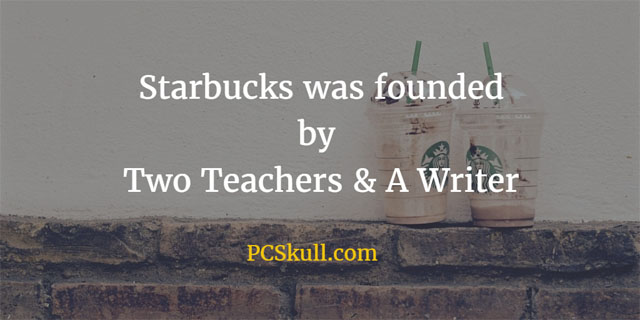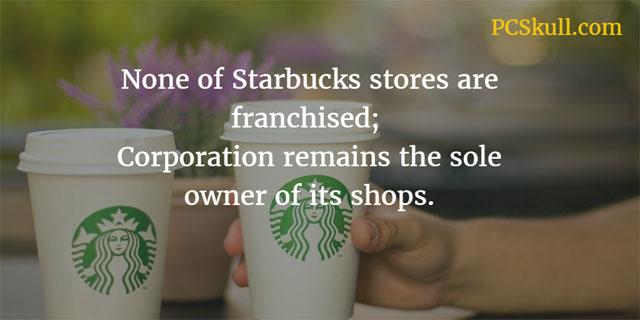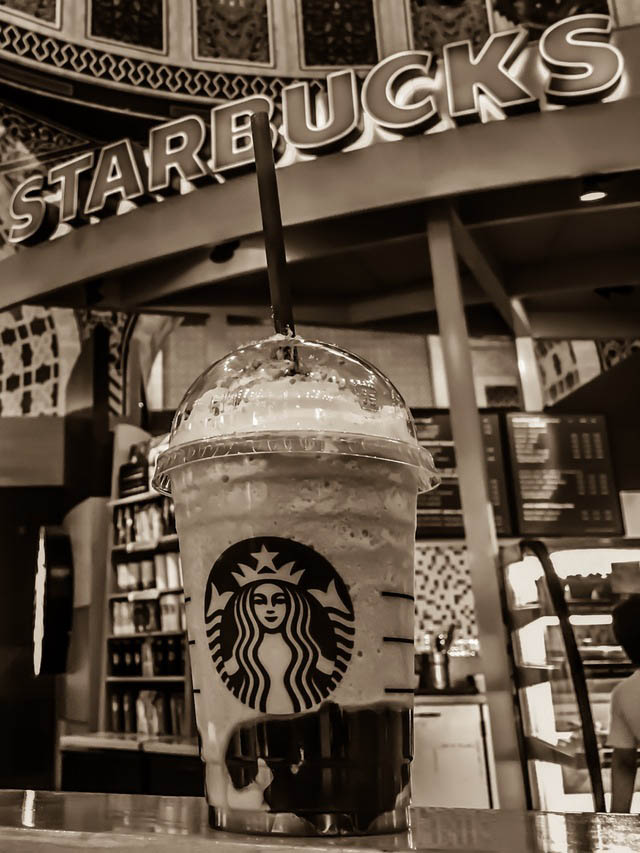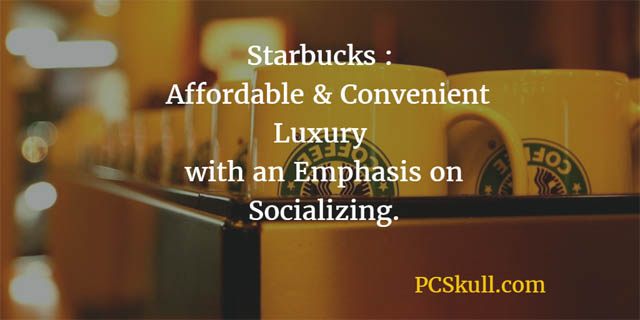Starbucks Marketing Strategy: It’s About More than Just Coffee
Do you like coffee?
Would you call yourself a coffee aficionado?
Even if you don’t, there’s a huge chance you’ve heard of Starbucks. Maybe you’ve even been to one of their cafes without noticing or putting much thought into it.
Starbucks has been around for a while. It was started in 1971 by J. Baldwin, G. Bowker, and Z. Seigel.

The business began with the goal of providing the US consumer with a high-quality blend of coffee. The brand enjoyed a massive expansion trend across the years. Over 23 thousand stores are servicing customers in 72 countries across the world. In this post, we see their dominant Starbucks marketing strategy to make it a big brand.
“Our mission: to inspire and nurture the human spirit – one person, one cup and one neighborhood at a time.”
–Starbucks
Sponsorship allow them to branch out, the recent one with Spotify (a music streaming service) helps to bring Starbucks Music to life.
The main attraction of Starbucks is coffee, of course. It comes in many different flavors, sizes, and iterations.
Contrary to what you might think, this coffee chain does not exclusively offer coffee. A wide assortment of teas, frappuccinos, lattes, juices, pastries, chips, crackers, beer, wine, smoothies, sandwiches, and the occasional snack round out the selection.
Having a loyal customer base helps, especially when they’re launching a new, original seasonal treat. It can be a Pumpkin Latte or a free cup of Blonde Roast.
Starbucks is, arguably, the most recognizable brand name when it comes to coffee nowadays. What are their main attributes? An instantly familiar green-white logo? Is there a big-ticket item on offer? Maybe it’s those comfortable lounge shops they have?
Let us try to quantify the Starbucks marketing strategy and put it simple terms. If you are interested in the business rhetoric of a global brand or are merely trying to dig up interesting tidbits on your favorite retailer of caffeinated beverages, keep on reading.
Table of Contents
What Type of Business is Starbucks?
Well, it is a corporation, a publicly-traded entity. It wasn’t public all of the time, however.
None of the stores are franchised; the corporation remains the sole owner of its shops.

Since its inception, management strives for the company to be extremely customer-concentric.
Howard Schultz (the chairman and CEO of the company, took over the firm in 1987) published a book titled – Pour Your Heart Into It: How Starbucks Built a Company One Cup at a Time
It was initially published in 1997, and the book gave insight into how the company was jump-started. In a nutshell, it’s a feel-good success story of entrepreneurial efforts.
An inspiring read, actually. It may be invaluable to aspiring managers and marketers alike, but having a smart business plan and pursuing relentlessly sometimes might not cut it; especially in such a competitive and saturated market as it is now. What may seem like an easily attainable goal from a business standpoint according to Schultz’s philosophy, would require extensive planning and analysis phases.
Company’s success spawned a major number of small startups and copycats, trying to cash in on the minimal advertising approach Starbucks is so well-known for. They use less money for Starbucks marketing strategy to promote their business.
As if there’s a magical formula that can help anyone grow a company into a successful, globally available chain of superstores.
Starbucks is more of an exception in this situation, not a rule.
Advertising Methods as a Starbucks Marketing Strategy:

The company managed to survive and evolve without much advertising in an era of rapid technological development. Hands-off direction to advertising yielded good results, a surprising turn of events in itself.
Starbucks historically had modest marketing budgets and never relied on aggressive marketing. Instead, they opted in for a more subtle approach.
The company had some rough patches due to it, but Starbucks cashed in rather well on the social media boom with viral campaigns and their first-generation e-commerce division.
With the advent of social networks, word of mouth and social presence became a driving marketing force.
You visit their store. Have a grand time and immensely enjoy one of their products. You might be inclined to tweet or upload an image of the beverage (or what have you) in question to Instagram if it’s something you like doing.
Your friend/relative/fiancee might follow suit and even be inclined to formulate a very verbose comment regarding a special kind of coffee they had once.
The Internet is a big place, and social media is one of the biggest cogs in a huge machine that is marketing.
Staying relevant and being ahead of the curve takes the front seat of marketing efforts, as well as adopting new strategic avenues. This is what the Starbucks marketing strategy.
Starbucks likes to position itself as a home away from home – a place of R&R in a busy life of the everyday person.
Where does Starbucks advertise?
Howard Schultz thought of their storefronts as billboards. Local Starbucks marketing strategy and stores in densely populated areas provided a sufficient enough customer flow at the time, allowing the word of mouth and convenient placement be the main driving force for expansion.
A bold move, not giving much thought to traditional ad campaigns. Their shops became more of a social phenomenon, a place of gathering and a recommendation hub.

With so many items on offer, it’s increasingly hard to hit the jackpot. It’s easier to get a recommendation from a friend/co-worker about this wonderful dark roasted coffee they’ve once had, but playing the betting game can be fun in its own right.
Wildly popular among students, they spend so much time in Starbucks they have to buy college essays to not fail their classes.
Promotion Plan and Starbucks Marketing Strategy:
The main crux of corporate philosophy is to provide unparalleled service to its customers and maintain a high level of employee satisfaction.
This is where social media comes into play yet again.
Customer incentivization comes from promotions. They present themselves in membership rewards:
Every patron is free to apply for a membership card; it has 3 (three) levels displaying customer loyalty — Welcome Level, Green Level, and Gold Level. Perks include free refills, a free drink every 12 (twelve) purchases. As well as a birthday offering.
In turn, it keeps the audience engaged and ready for future promos – ready to pounce on the opportunity with countless retweets, likes, and shares.
Seasonal offerings are a novelty attraction for new and recurring customers.
Drinks are always the way you want them as well, so having a highly-trained barista for the purpose of dealing with personalized orders is a consistent way to provide an intimate experience for the customer.
The complexity of ordering goes way beyond the typical: I’ll take a regular coffee, please. It has turned into an attraction in itself. Orders are very specific and highly customizable, it can be downright obnoxious to pronounce an order at times. A perfect case for the snobs and people that turned the ordering game into a special event.
You’re welcome to simply come and hang out, soak in the atmosphere, listen to music or participate in a conversation at personal leisure. The concept of a lounge, in short.
Starbucks is said to be an affordable and convenient luxury with an emphasis on socializing. A staple meeting place for young and adults alike. For people of many crafts and vocations.

Starbucks relies on premium ingredients for their caffeinated products, which in turn drives the price up. It hinders their expansion into new markets and gives them a competitive advantage in the affordability departments.
Franchising is actively avoided in the Starbucks marketing strategy.
Store wi-fi, book reader events, music showcasing and presence in supermarket chains all make a great case for the brand.
Not difficult to notice a trend of globally-oriented policy – continuous expanse into emerging markets of Asia and Africa was only a question of time.
Global presence functions as a marketing tool in a way, the one that transcends language and cultural boundaries. This also comes through in the form of diversification and appealing to a range of demographic outliers. They offer a bigger product range and install a price adaptation strategy to appeal to a wider audience. Although the change in taxation policies, licensing and permits may prove to be a major hindrance.
Unsurprisingly, the biggest presence is observed in the North American market — the United States and Canada.
Improving brand loyalty by providing timely, dignified service. One customer at a time.
However, being at the top of the market brings a slew of problems with it — competing brands may evolve faster in terms of their business plans and jump-start a marketing arms race, so to speak. Bigger budgets, analysis, marketing plan revisions, etc.
Many people become inspired by the success story of Starbucks and entertain the notion of starting a small business from scratch. Additional insight into important social media marketing strategy of Starbucks makes a convincing case for any future advances of your enterprise.
Starbucks Business Level Strategy:
First and foremost, Starbucks is a business. Profitability and sustainability are key. No problems in that department. They possess a sizable amount of experience in the field. Being on the market for about 47 years at this point.
Starbucks gained a dynamic in profitability, and a recent trend is ranging from 20% to 40% in yearly growth.
Among other things, an environmentally-friendly position was adopted by Starbucks. Recycling is high on the agenda with increasingly degradable cups and bags; recognizing environment issues and installing environmental responsibility as a corporate value.
Starbucks is known for pursuing charitable causes — like FoodShare, for example. A program that allows people with disposable incomes to act as benefactors.
Extended reach of their market is evident with open chains on all the major continents, even Africa. A surprising appearance in emerging markets.
Incidentally, it’s one of their strategic problems. The constant shifts in the economy create a power struggle when the intention is to open up new global frontiers.
The core beliefs are unity; comfort; respect; high level of service; profit.
Providing high-quality service and a stress-free environment for employees and customers alike. They know their craft, that much is certain. Employees (or partners rather, since according to corporate philosophy it’s not simply a job, it’s a passion) receive a full set of perks which are tailored individually – Your special brand.
This special brand may manifest itself in:
- health insurance/coverage (medical, dental, vision, etc.);
- 401(k) retirement program;
- stock purchase as an option to get a bigger stake in the company;
- education and tuition opportunities;
- decent pay grade;
- free coffee.

Sounds good so far, right?
Starbucks knows how to double the profit with employee engagement strategy to grow their business.
In closing, should Starbucks have pursued a more convincing marketing ideology? Perhaps. Being focused on premium ingredients slightly limits Starbucks’ market share, especially in developing markets.
But at the same time, it provides something else, something more than simply coffee — camaraderie, easygoing social interactions, a place of rest & relaxation.
Everyday life gets more and more frantic, filled with busywork and obligations. Sometimes you just want to take a pause and enjoy a simple pleasure. To get into a personal safe place for a brief respite.
A brand campaign launched way back in 2014 called “Meet me at Starbucks,” grants everyone a peeks into Starbucks“ policies.
This 5-minute behind-the-scenes glimpse is one of their recent global efforts. Filmed within a grand span of a day, it shows a vertical slice of footage from 28 Starbucks cafes all over the world. A joyful study of patrons having a grand time. As promotional videos go, this one had a fitting musical score. It“s not surprising to discover people wanting to go and visit Starbucks in a meeting or a working capacity.
Creating and nurturing a friendly setting for its customers; offering a high degree of service is what Starbucks is about and Starbucks marketing strategy.
Related Read: 5 Business Development Strategies to Grow Business
Look no further:
If you ever need a fitting backdrop for your social calls. It remains popular and for a reason. Decades of improvement and development. They mastered Starbucks marketing strategy, the no-ad approach and excellent customer relations to create an image of your regular neighborhood coffee shop, but on a much more massive scale. Not just for you, for everyone.
